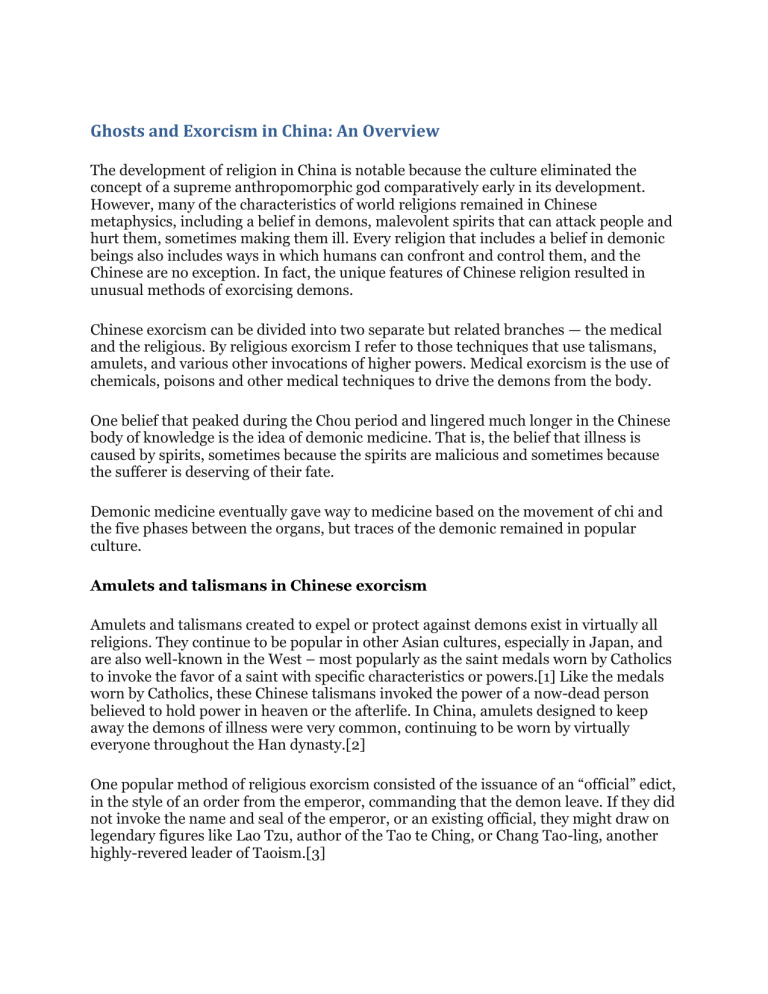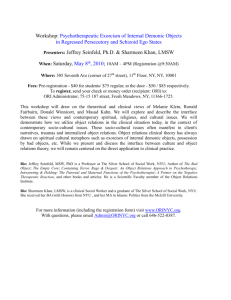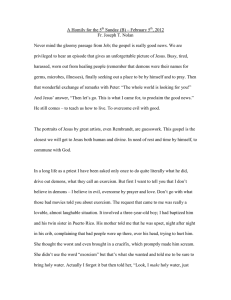
Ghosts and Exorcism in China: An Overview The development of religion in China is notable because the culture eliminated the concept of a supreme anthropomorphic god comparatively early in its development. However, many of the characteristics of world religions remained in Chinese metaphysics, including a belief in demons, malevolent spirits that can attack people and hurt them, sometimes making them ill. Every religion that includes a belief in demonic beings also includes ways in which humans can confront and control them, and the Chinese are no exception. In fact, the unique features of Chinese religion resulted in unusual methods of exorcising demons. Chinese exorcism can be divided into two separate but related branches — the medical and the religious. By religious exorcism I refer to those techniques that use talismans, amulets, and various other invocations of higher powers. Medical exorcism is the use of chemicals, poisons and other medical techniques to drive the demons from the body. One belief that peaked during the Chou period and lingered much longer in the Chinese body of knowledge is the idea of demonic medicine. That is, the belief that illness is caused by spirits, sometimes because the spirits are malicious and sometimes because the sufferer is deserving of their fate. Demonic medicine eventually gave way to medicine based on the movement of chi and the five phases between the organs, but traces of the demonic remained in popular culture. Amulets and talismans in Chinese exorcism Amulets and talismans created to expel or protect against demons exist in virtually all religions. They continue to be popular in other Asian cultures, especially in Japan, and are also well-known in the West – most popularly as the saint medals worn by Catholics to invoke the favor of a saint with specific characteristics or powers.[1] Like the medals worn by Catholics, these Chinese talismans invoked the power of a now-dead person believed to hold power in heaven or the afterlife. In China, amulets designed to keep away the demons of illness were very common, continuing to be worn by virtually everyone throughout the Han dynasty.[2] One popular method of religious exorcism consisted of the issuance of an “official” edict, in the style of an order from the emperor, commanding that the demon leave. If they did not invoke the name and seal of the emperor, or an existing official, they might draw on legendary figures like Lao Tzu, author of the Tao te Ching, or Chang Tao-ling, another highly-revered leader of Taoism.[3] While the issuance of an edict or order demanding that a demon leave its host might seem strange, it actually makes a great deal of sense in the wider scope of Chinese culture. As early as the Shang dynasty, the oldest period of Chinese history from which records exist, the emperor was regarded as a semi-divine figure who could contact and interpret the will of the god Tien. Later during the Han period, when the demonic medicine of the Chou had been largely set aside, the idea of a Celestial Bureaucracy of gods and demons that mirrors the Chinese government on earth would become widespread and popular. The orders and actions of the government on earth affected the stars above just as much as the reverse was true. Thus it’s easy to see that the Chinese have a long history of believing that humans, while not equals of demons and gods, can have great effect on them, and in particular the government and its officials have power over both the natural world and the supernatural world. The officiant’s order of a demon out of a body is also not so unusual. The power of the emperor was such that the rightness or wrongness of his behavior could cause the heavens to move out of sync. From there it seems entirely reasonable to assume that they also have the authority to order demons and other spirits about. The exorcisms of the Chinese are a rather mundane sort of appeal to authority in comparison to many religions. While others call on gods or angels, they are calling on famous ancestors or the still-living emperor to placate the demons. It is clear from both the cultural history of ancestor worship and the deification of various emperors and high-ranking officials that the Chinese hold their officials in high regard with respect to the afterlife. In addition, the Chinese held the exorcists themselves in high esteem, often going to extreme lengths to comply with the sometimes bizarre demands of exorcism rituals. One example set in Fuzhou, among many in Hong Mai’s (1123-1202) twelfth-century collection, the Yijianzhi, depicts the cure of a virgin’s false pregnancy in a series of theatrical scenes. Two small boys dive into a pond as the rituals are taking place, and apparently drown. Their angry parents threaten to turn the spirit medium over to the county magistrate. She (or he) asks for patience to give her arts time to work. The village people gather round the pond and wait. Suddenly, amid a series of explosions like thunder, the two boys emerge unscathed from the water dragging the carcass of the culprit, a huge carp. The medium exorcises its curse and terminates the false pregnancy by smashing crockery placed on the girl’s distended belly.[4] As the author goes on to state, this story is a wonderful example of the pomp and show involved in Chinese ritual exorcism. Ritual played an important role in virtually all aspects of Chinese religion, especially in later Taoist and Confucian developments. Exorcism rituals could be very complex. For example, a manual for exorcising ghosts that descends from the Yi people of China details a ritual that could take as little as one night or as many as nine to complete, and calls for the attendance and assistance of not only the exorcist and the head of the family being helped, but the entire neighborhood.[5] Another very dramatic ritual, and one of the most interesting examples of exorcism in China, is the so-called Great Exorcism, which is at least as old as the Chou dynasty and may date from even earlier times. It was performed during the winter to expel plague from the land using a number of exorcists: The Great Exorcism as celebrated at court was a violent and intense ritual, with youths under the command of an exorcist racing around the palace carrying torches and screaming imprecations at the top of their lungs in order to expel demonic creatures responsible for epidemics and other calamities.[6] This sort of exorcism drew on the popular mythology of demons causing plague and illness, the “demonic medicine” discussed earlier. To defend themselves against these plague demons, the Chinese did not call upon gods as we know them, but upon human beings who had ascended after death to places in the celestial bureaucracy. One of those popularized this way was Zhong Kui, who reportedly appeared to the emperor Xuanzong in a dream and vanquished the demon that was making him ill. Formerly an aspiring civil servant who committed suicide, Zhong Kui was popular during the Tang dynasty and remained in exorcism references well beyond the Han dynasty. References to him are found in many places relating to exorcism: an exorcist’s hammer is called a zhongkui, for example, and many ritual New Year’s dances are named after or reference him. Hanging a painted or printed illustration of Zhong Kui above the door gate on the eve of the New Year became virtually a universal custom in Song times. Indeed, nearly all references to Zhong Kui in TangSong times pertain to these portraits. Zhong Kui never became an independent deity, an object of sacrifice and prayer with his own shrines. Instead, Zhong Kui’s demon-quelling powers were channeled through the talismans bearing his image.[7] Also, at various points, written charms of exorcism not unlike the talismans described above were burned and the ash was made into a potion that was then given to the ill person.[8] While drawing from the strong traditional use of talismans and amulets, this method also carried the beginnings of the medical exorcism, where substances put into the body were thought to affect the offending demon. To learn more about this sort of procedure, one can turn to a book known as the Chu yu shih-san kho. Among its contents are a number of talismans and rituals used to treat smallpox infections. They vary in terms of their focus – they may be aimed at any number of symptoms – but they are all administered in the same way. Each is written on paper in red cinnabar ink and burnt. The ashes are then administered via liquid. [9] Medical treatments in Chinese exorcism The medical treatments associated with Chinese exorcism are largely unique. While some varieties of exorcism accept medical assistance – for example, many Catholic exorcists now work closely with psychologists and attending physicians to assure the health of the victim – throughout history, exorcists and other religious-based diagnoses have either been supplanted by or in opposition to a purely medical diagnosis. Only in a system with China’s unique relationship with God could demonic medicine exist. While there are many cultures where a religious or spiritual doctor will treat your illness with prayer or sacrifice, it was the Chinese who believed that demons were only a part of nature just as heaven and earth were. This surety led them in the direction of five-phases medicine, where the demonic “middle man” between symptoms and diagnosis was removed. This can be seen in the development of vocabulary used in the treatment of illness. The hsieh-kuei or demons that were attributed the cause of disease in the older system were eventually transformed into hsieh-chi or evil influences that were non-sentient and resulted not from a desire to cause harm on the part of a demonic being but from wind and other natural causes affecting energy imbalances in the body.[10] Before this shift occurred, however, medical treatments that addressed the reality of demons with potions and drugs. Author Paul Unschuld recounts a story from the Tsochuan of the medical expert Li Tsze-yu. Tsze-yu was called before the governor of a province to heal his brother, and did so by “taking a red ball, compounded of eight poisonous substances, out of his linen box” and giving it to the afflicted man to eat.[11] This method was referred to as new in the third or fourth century, but within two hundred years had become accepted. Many illnesses were treated with poisonous substances in these times, perhaps reflecting recognition of the fact that sometimes one has to get worse before one can get better. It seemed sensible to assume that that which harmed other beings could also harm a demon. In a compilation dating from about 600 AD, there are recipes for such treatments. The importance of medical techniques for treating exorcism and demonic influence could only result from a culture like China. The lack of an overarching God figure keeps the Chinese dependent on themselves instead, and thus without the separation between supernatural and natural medicine and illness, it became easy for them to treat what were believed to be demonic causes with chemical or physical treatments. Though the literal demons were later put aside in favor of concepts of chi and various natural forces that caused the body to fall ill, the holistic medical approach never truly fell out of favor in China. Use of acupuncture and other traditional medicine continues in tandem with Western medicine. Acupuncture is the practice of inserting needles at various points in the human body to control and redirect the flow of chi or energy. It is the aspect of Chinese medicine most well-known in the West, and is generally used to treat joint or muscle problems. It has a wider variety of uses in its homeland, however. Traditionally, there exist thirteen acupuncture points used specifically for exorcising purposes. The needles used in this case not only enter the body to direct chi energy, but they are also symbolic of the use of spears in early exorcism rituals.[12] It is possible that the use of acupuncture in this situation represents an effort to cause the body’s chi to overpower and cast out the demon, and logically appears to be a link between the earlier treatment of illness in demonic medicine and the later treatment of evil influences or bad chi built up in the body. Ultimately, medical exorcism has ties to religious exorcism, and similarly, religious exorcism ties in with medical exorcism. The two are inseparable because they serve the same purpose – the removal of demons or harmful spirits from the body. The nature of belief in China, where the most powerful demons and beneficent spirits are the spirits of dead humans, the ancestors who have come before us, left an indelible footprint on all aspects of their culture. The art and science of expelling these spirits from those they torments is no different. The way in which the Chinese weave “religion” and “science” into a single art through their history allowed them to avoid the battle between religious and scientific paradigms that became to pervasive in the west and to apply medical treatments such as potions and acupuncture to the more traditionally spiritual realm of demonology with no apparent contradiction. This gives Chinese exorcism a different and distinct flavor from that found in other early cultures. Bibliography Baptandier, Brigitte. “The Lady Linshui: How a Woman Became a Goddess,” Unruly Gods: Divinity and Society in China. University of Hawaii Press: Honolulu HI, 1996. Davis, Edward L. Society and the Supernatural in Song China. University of Hawaii Press: Honolulu HI, 2001. Katz, Paul R. Demon Hordes and Burning Boats: the Cult of Marshal Wen in Late Imperial Chekiang. State University of New York Press, Albany NY, 1995. McCurley, Dallas. “Performing Patterns: Numinous Relations in Shang and Zhou China.”TDR: The Drama Review – Volume 49, Number 3 (T 187), Fall 2005, pp. 135156 Needham, Joseph and Dieter Kuhn. Science & Civilization in China. Cambridge University Press: Cambridge, England, 1954. Ritual for Expelling Ghosts: A Religious Classic of the Yi Nationality in Liangshan Prefecture, Sichuan. Taipei Ricci Institute: Taiwan, 1998. Sutton, Donald S. “From Credulity to Scorn: Confucians Confront the Spirit Mediums in Late Imperial China.” Late Imperial China – Volume 21, Number 2, December 2000, pp. 1-39 Unschuld, Paul U. Medicine in China: A History of Ideas. University of California Press: Los Angeles, 1985. Von Glahn, Richard. The Sinister Way: the Divine and the Demonic in Chinese Religious Culture. University of California Press: Los Angeles, 2004. Endnotes [1] Thurston, Herbert. “Medals, Devotional,” the Catholic Encyclopedia. [2] Unschuld, Paul. Medicine in China. (University of California Press: Los Angeles, 2004), p 39. [3] Unschuld, Medicine, p 40. [4] Sutton, Donald. “From Credulity to Scorn,” Late Imperial China. p 9. [5] Bamo, Ayi. “Introduction”, Ritual for Expelling Ghosts. (Taipei Ricci Institute: Taiwan, 1998), p xxxii. [6] Katz, Paul. Demon Hordes and Burning Boats. (State University of New York Press, Albany NY, 1995), p 64. [7] Von Glahn, Richard. The Sinister Way. (University of California Press: Los Angeles, 2004), pp 122-123. [8] Unschuld, Medicine, p 39. [9] Needham, Joseph and Dieter Kuhn. Science & Civilization in China. (Cambridge University Press: Cambridge, England, 1954), pp 159-160. [10] Unschuld, Medicine, p 68. [11] Unschuld, Medicine, p 41. [12] Unschuld, Medicine, p 45.





